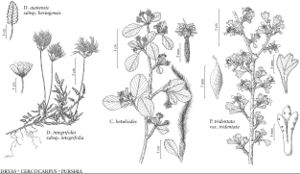Purshia tridentata var. tridentata
Stems: young long-shoots arachnoid-villous to pubescent curved hairs 0.1–0.4 mm, stipitate-glandular or not. Leaves dimorphic, long-shoot and most short-shoot leaves summer–winter deciduous; blade flabelliform, thin, margins weakly revolute, usually 3-toothed, sometimes 3-lobed, apically, not punctate or rarely with sessile or stipitate-glands but these not strongly resinous, abaxial surface white arachnoid-villous to arachnoid-tomentose, adaxial persistently arachnoid-villous (hairs crinkled) and hirtellous; late-season short-shoot and sometimes first-formed (proximalmost) spring short-shoot leaves winter-persistent, remaining at base of new season’s growth, smaller, thick, 3-lobed distally, margins with or without resinous punctate glands, glabrous or hirtellous. 2n = 18.
Phenology: Flowering Mar–Jun(–Jul).
Habitat: Mostly well-drained alluvial plains, sagebrush scrub, grasslands, pinyon-juniper woodlands, yellow pine, red fir forests, subalpine zones
Elevation: (60–)1000–2500(–3400) m
Distribution

B.C., Ariz., Calif., Colo., Idaho, Mont., Nebr., Nev., N.Mex., Oreg., Utah, Wash., Wyo.
Discussion
Plants of var. tridentata have dimorphic leaves. Short shoots typically produce thick glandular-margined, overwintering leaves in the later summer (and sometimes in early spring) and thinner, flabelliform winter-deciduous leaves in spring and summer or only on long shoots. Variation in persistent and deciduous leaves occurs through the range, with northern plants producing mostly thinner deciduous leaves and plants in more arid zones to the south producing more thick, persistent and fewer thin, deciduous leaves. At high elevations in the White Mountains of Inyo County, California, low vegetative plants have only thick, persistent leaves as in var. glandulosa, except that long-shoot leaves are of the thin, deciduous type characteristic of var. tridentata. In more arid regions plants produce only thick, persistent leaves on both long and short shoots, characteristic of var. glandulosa with a broad zone of transition between the taxa. The persistent leaves provide important, high-protein winter browse for ungulates. Development of stipitate glands on stems, leaves, and hypanthia is highly variable even within populations.
Selected References
None.
Lower Taxa
"thin" is not a number."dm" is not declared as a valid unit of measurement for this property.
